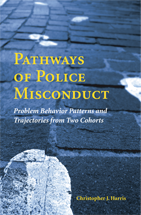Pathways of Police Misconduct
Problem Behavior Patterns and Trajectories from Two Cohorts
2010
Tags: Law Enforcement
214 pp $25.00
ISBN 978-1-59460-632-8
eISBN 978-1-5310-0307-4
This book explores a new framework for understanding police misconduct, specifically that misconduct can be examined across careers to better understand its causes and explore avenues for its control. Since the vast majority of police research is cross-sectional, little is known about longitudinal patterns of police misconduct.
Previous research has found that a small percentage of officers—called problem officers—account for a disproportionate amount of misconduct. Despite this, little empirical research has been done on problem officers, and such research has not been adequately driven by theory. Before such research can be undertaken, a theoretical framework where one could understand the misconduct of police officers over time must be developed.
As such, this research draws upon the criminal career paradigm and developmental criminology more generally, as both have a well developed lexicon for understanding patterns of antisocial behavior over time. This book argues that police misconduct (a) varies in important ways over time by the year of experience as an officer, and (b) can be considered as a distinct developmental trajectory of behavior.
This work presents analyses of a retrospective, longitudinal data set of police personnel complaints and related misconduct indicators from a large police agency. Borrowing lessons learned from the criminal career paradigm and developmental criminology, it seeks to determine if there is a relationship between experience and misconduct of officers at the aggregate level, and whether distinct trajectories of misconduct, such as that of a problem officer, underlie this aggregate curve.
The results indicate that experience and misconduct are related in an orderly way in the aggregate. What's more, there are distinct trajectories of misconduct underlying this curve. The implications of these findings for both police scholars and police administrators are also discussed.


